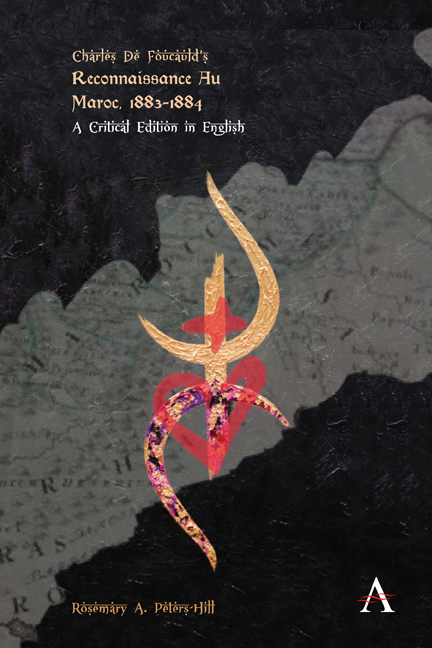Book contents
- Frontmatter
- Contents
- List of Figures
- Acknowledgments
- “There are no roads”: Charles de Foucauld’s Reconnaissance au Maroc—a Critical Introduction
- Charles de Foucauld, Reconnaissance au Maroc, 1883–1884
- Letter to François de Bondy
- Introduction
- Avant-Propos
- I Tangiers to Meknès
- II Meknès to Qaçba Beni Mellal
- III Qaçba Beni Mellal to Tikirt
- IV Tikirt to Tissint
- V Sojourn in the Sahara
- VI Tissint to Mogador
- VII Mogador to Tissint
- VIII Tissint to the Dadès
- IX The Dadès to Qçabi ech Cheurfa
- X Qçabi ech Chorfa to Lalla Maghnia
- Appendix: The Jews of Morocco
- Note on the Materials Used to Draw Up My Itinerary
- Report Delivered to the Société de Géographie de Paris in Its General Session of 24 April 1885
- “Itineraries in Morocco”
- Afterwards: An Afterword
- Glossary of Terms
- Bibliography
- Index
V - Sojourn in the Sahara
Published online by Cambridge University Press: 20 January 2022
- Frontmatter
- Contents
- List of Figures
- Acknowledgments
- “There are no roads”: Charles de Foucauld’s Reconnaissance au Maroc—a Critical Introduction
- Charles de Foucauld, Reconnaissance au Maroc, 1883–1884
- Letter to François de Bondy
- Introduction
- Avant-Propos
- I Tangiers to Meknès
- II Meknès to Qaçba Beni Mellal
- III Qaçba Beni Mellal to Tikirt
- IV Tikirt to Tissint
- V Sojourn in the Sahara
- VI Tissint to Mogador
- VII Mogador to Tissint
- VIII Tissint to the Dadès
- IX The Dadès to Qçabi ech Cheurfa
- X Qçabi ech Chorfa to Lalla Maghnia
- Appendix: The Jews of Morocco
- Note on the Materials Used to Draw Up My Itinerary
- Report Delivered to the Société de Géographie de Paris in Its General Session of 24 April 1885
- “Itineraries in Morocco”
- Afterwards: An Afterword
- Glossary of Terms
- Bibliography
- Index
Summary
Tissint
Upon arriving in Tissint, a new region began for me: the sky, crops, people, dress—everything is different here from what I have seen before this day. Until now I was in mountainous country, with the climate and products of southern Europe. The inhabitants were the Chellaha, almost all dressed in white wool. That country had the Bani as its border. When we enter Tissint, after crossing the Bani, we set foot into a new world. Here, for the first time, the eye is drawn toward the south but sees not a single mountain: the region to the south of the Bani is an immense plain, sometimes white, sometimes brown, its rocky solitudes stretching out as far as the eye can see; a line of azure borders it at the horizon and separates it from the sky: this embankment is the left bank of the Drâa, beyond which begins the Hamada. This scorched plain has no vegetation besides some stunted gum-trees, no other relief than narrow ranges of hills, rocky, interspersed, and twisted around like sections of serpents. Alongside the cheerless desert are the oases, with their wonderful vegetation, forests of palm trees always green, qçars replete with wellbeing and wealth. Working in the gardens, stretched out nonchalantly in the shadow of the walls, squatting by the doorways of houses and smoking, one perceives a numerous population of men with black faces, Haratîn of a very dark color. Their clothes strike me first of all: all are dressed in indigo cotton, a fabric from the Sudan. I am in a new climate: there is no winter here; they sow in December, reap in March; the air is never cold; above my head, a sky ever blue,
Where never floats a cloud,
Is vast, implacable, pure.
Tissint is one of the largest oases of the Moroccan Sahara. It is located at the bottom of a basin whose edges are the Bani on one side and a ring of hills—rocky to the south, sandy to the east and west—on the other. In the middle of this circle stretches a plain of white sand: there stands the oasis, a forest of palm trees crossed by a lovely river, with qçars rising up to the edge of the groves.
- Type
- Chapter
- Information
- Charles de Foucauld’s Reconnaissance au Maroc, 1883–1884A Critical Edition in English, pp. 239 - 288Publisher: Anthem PressPrint publication year: 2020



